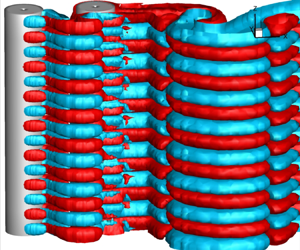Article contents
Three-dimensional transition in the wake of two tandem rotating cylinders
Published online by Cambridge University Press: 08 November 2022
Abstract

Three-dimensional (3-D) transition in the wake of two tandem co-rotating cylinders is studied numerically for Reynolds numbers  $180\le Re\le 500$. Infinite cylinders of equal diameter (
$180\le Re\le 500$. Infinite cylinders of equal diameter ( $D$) and span (
$D$) and span ( $8D$) are placed at streamwise gaps
$8D$) are placed at streamwise gaps  $Lx=2.5D$ and
$Lx=2.5D$ and  $7.5D$, and rotated at rotation rates
$7.5D$, and rotated at rotation rates  $\alpha =0$,
$\alpha =0$,  $0.5$,
$0.5$,  $1$ and
$1$ and  $2$. For
$2$. For  $\alpha =0$ and
$\alpha =0$ and  $Lx=7.5D$, 3-D transition in the wake of the upstream cylinder resembles that for an isolated cylinder with the formation of Mode-A and Mode-B instabilities, whereas for the downstream cylinder, only Mode-A instability occurs in both the
$Lx=7.5D$, 3-D transition in the wake of the upstream cylinder resembles that for an isolated cylinder with the formation of Mode-A and Mode-B instabilities, whereas for the downstream cylinder, only Mode-A instability occurs in both the  $Lx=2.5D$ and
$Lx=2.5D$ and  $7.5D$ cases with
$7.5D$ cases with  $\alpha =0$. When the cylinders rotate at
$\alpha =0$. When the cylinders rotate at  $\alpha =1$ for
$\alpha =1$ for  $Lx=7.5D$, staggered transition takes place with the appearance of only Mode-B and only Mode-A instabilities in the near-wake regions of the upstream and downstream bodies, respectively. In the case
$Lx=7.5D$, staggered transition takes place with the appearance of only Mode-B and only Mode-A instabilities in the near-wake regions of the upstream and downstream bodies, respectively. In the case  $Lx=2.5D$, the wake of the rotating cylinders transitions via Mode-C and Mode-D instabilities for
$Lx=2.5D$, the wake of the rotating cylinders transitions via Mode-C and Mode-D instabilities for  $\alpha =0.5$, Mode-D and Mode-D
$\alpha =0.5$, Mode-D and Mode-D $^\prime$ for
$^\prime$ for  $\alpha =1$, and Mode-C and Mode-A for
$\alpha =1$, and Mode-C and Mode-A for  $\alpha =2$. A sudden decrease in near-wake fluctuations, accompanied by a downward jump in the force coefficients, is observed as the 3-D instability shifts from one mode to another, for
$\alpha =2$. A sudden decrease in near-wake fluctuations, accompanied by a downward jump in the force coefficients, is observed as the 3-D instability shifts from one mode to another, for  $\alpha \ge 1$ and
$\alpha \ge 1$ and  $Lx=2.5D$. This discontinuity is caused by the formation of a pair of opposite-signed recirculation zones that mitigate each other's effects in the near-wake region.
$Lx=2.5D$. This discontinuity is caused by the formation of a pair of opposite-signed recirculation zones that mitigate each other's effects in the near-wake region.
Information
- Type
- JFM Papers
- Information
- Copyright
- © The Author(s), 2022. Published by Cambridge University Press
Footnotes
Present address: GE Research, John F. Welch Technology Centre, Bangalore 560066, India.
References
REFERENCES
- 8
- Cited by


